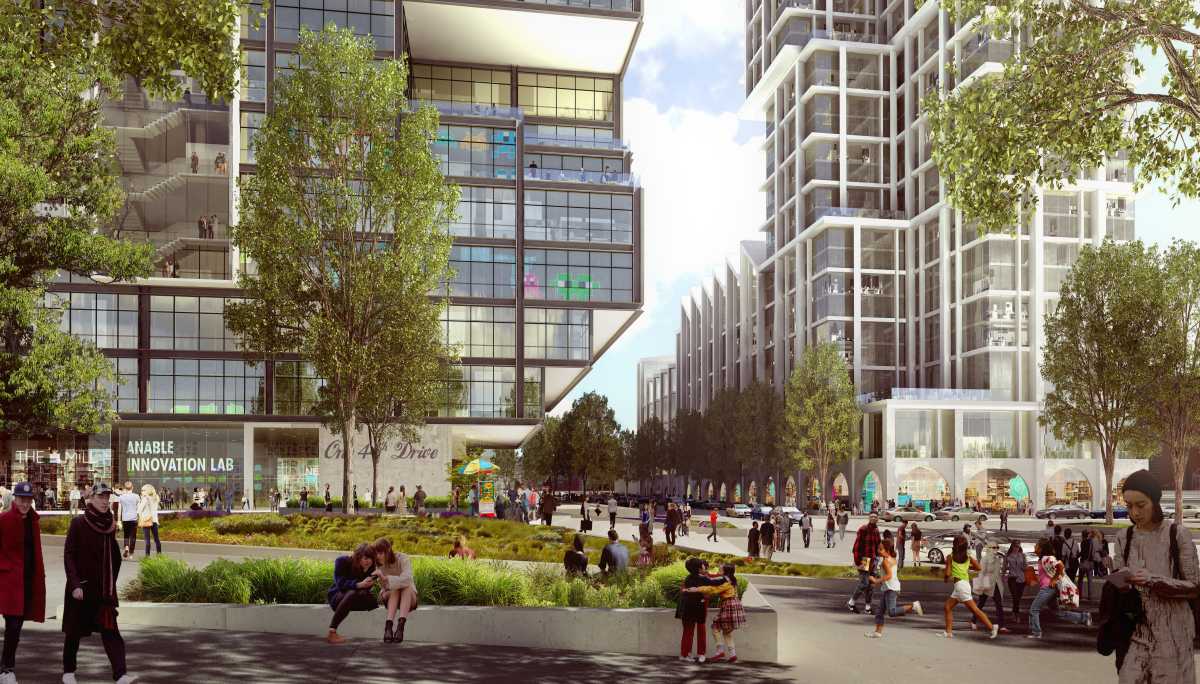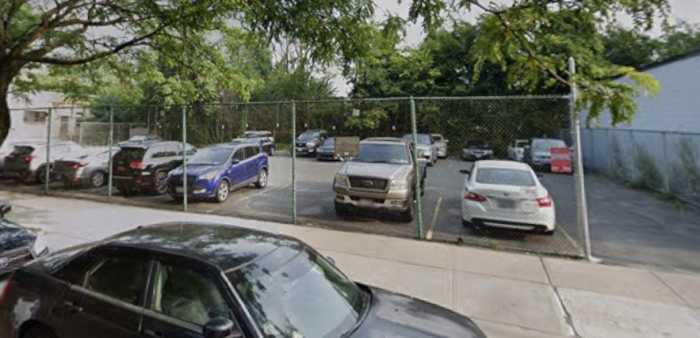Earlier this month, Long Island City residents rallied against a proposal to develop two city-owned lots along the waterfront. But developers are arguing that their plan was made with the community in mind.
Last July, Mayor Bill de Blasio announced that TF Cornerstone was chosen to develop two sites that sit on 44th Drive. The plan includes 1,000 units of housing, an elementary school, manufacturing and commercial space, a performance space and waterfront access.
Almost immediately after the plan was announced, residents began to express their disappointment at Community Board 2 meetings, through a petition and a rally held on March 3.
Since the land is publicly owned, residents feel that they should have been consulted before the city finalized any plans. According to the LIC Coalition, the group that created the petition, residents want a portion of the land to be turned into a wetland park. Since the sites sit in a flood zone, they argue that constructing large buildings would make the land vulnerable.
Residents also want to see a community recreation center, “school seats, artist and light manufacturing space, a cultural center, a climate change educational center, job training, space for NGOs and other community benefits,” the petition said.
Meanwhile, TF Cornerstone, which was responsible for most of the Queens West development, is looking to fulfill the city’s wishes by maximizing non-residential uses, according to Jon McMillian, the director of planning for the company.
“It’s a unique development because of what the city is trying to do here,” he said. “They’re essentially trying to maximize the non-residential stuff and minimize the residential stuff so that makes it a very special project. I think once the community starts to understand what’s really being planned here, they’re going to get much more comfortable with it.”
TF Cornerstone is working with partners C4Q to bring workforce training to local residents and the Greenpoint Manufacturing and Design Center (GMDC) to construct 100,000 square feet of affordable manufacturing space.
C4Q, a local nonprofit, aims to train Queens residents with all work backgrounds in coding and connect them to higher paying jobs.
“We think that there’s a lot of opportunity in reaching out to the housing authority at Queensbridge Towers,” McMillian said. “They are going to be a great beneficiary of the workforce training that we have on this site. Hopefully we’ll be able to work with C4Q to bring those folks in, train them and then place them in the companies that will be starting up in this facility.”
GMDC, a nonprofit developer dedicated to building affordable manufacturing space, will own and operate at least half of the 100,000 square feet dedicated to companies that need manufacturing space.
Clients will include artists, furniture design and fabrication, jewelry makers and other light industrial uses.
“They judge potential tenants by the number of jobs and quality of jobs so they’re trying to avoid warehousing and, similarly, general uses that are not noxious to residential uses,” said Jake Elghanayan, senior vice president. “There’s a high-tech quality that’s coming into play.”
The plan will also include 400,000 square feet of commercial space. Court Square and Queens Plaza were rezoned in 2001 to attract more commercial tenants. Instead, thousands of residential units were built in the area.
While C4Q will receive about 100,000 square feet for work training and 10,000 square feet will be dedicated to an incubator space, the majority of the plan will feature spec office space, meaning no tenants will be lined up before the building is constructed.
“There has been an effort to promote the definition of Long Island City as an office center around Citi Corp, Queens Plaza,” McMillian said. “That was what that zoning was supposed to be about. We’ve come along and we’re willing to do a spec office building to help Long Island City get started as a place where people work so people living here can walk across the street instead of getting into the overcrowded subway.”
A 600-seat elementary school, a performing arts space with dance studios for choreographers and dance companies and 1,000 units of housing are also included in the plan.
Though TF Cornerstone has said 25 percent of the units will be deemed affordable, that number is “fluid” and McMillian said it could change after conversations with Councilman Jimmy Van Bramer.
“That was our opening bid that’s probably going to change over time once we negotiate this with Jimmy Van Bramer,” McMillian said. “He’s made that very clear that he’d like to see more affordable housing.”
Van Bramer attended the rally and made remarks against the development.
Elghanayan said the plan goes “beyond the simplistic affordable housing debate.”
“Part of affordability is incomes,” he said. “Even though affordable rents have been relatively flat, incomes have been even lower, so part of the story here is helping [create] jobs because that’s part of the affordability discussion.”
TF Cornerstone will spend about $100 million on remediation work along the waterfront and are planning to raise the site about 13 feet to protect against future storms. The community is requesting that wetland park be constructed but McMillan said the park is not a big enough solution.
“The flaw with that is that the flooding we’re trying to protect ourselves from is ocean surge where literally the sea level rises like in a [Hurricane] Sandy, and when the sea level rises the water is going to go absolutely everywhere it can up to a certain elevation, so the levels of water involved in those incidents are so enormous.”
The plan will create an acre of public space and local retailers will anchor the office building near the waterfront.
Developers will also open an event and catering space at The Water’s Edge property, which previously housed a similar company that closed after the owner was arrested for financial crimes.
The Developers are also working with Plaxall, who own the adjacent properties and are planning to rezone the area for development, to “lift up the edge condition” all along the Anable Basin.
“We have joint meetings with city planning all the time with Plaxall to make sure the projects plug in together,” McMillian said. “Our open spaces meet together [so with Plaxall we put together] comprehensive resiliency plans. We’re doing a lot of work with Plaxall.”
Developers said they were surprised by the amount of pushback from the community after the plan was announced.
“We think of our reputation in Queens as very important,” Elghanayan said. “It’s where my dad and uncles [founders of TF Cornerstone] are from and I think we were not expecting such a negative response. We don’t want to be the developers coming in and upsetting people.”
Members of the LIC Coalition argued that this plan would not preserve the kind of businesses Long Island City needs.
“There is no evidence to support the idea that this type of development will preserve small manufacturing, the arts or existing retail,” the group said. “Historically the opposite is true. What it does is continue to attract designers, photographers, tech companies and retail startups being priced out of Manhattan. This creates increased competition and higher costs. That is understandably what the developers want and that is why the city should not be giving city land to a private developer.”
According to TF Cornerstone, about 25 percent of the manufacturing businesses currently looking to move to GMDC sites in Brooklyn have been displaced from Long Island City due to high rents.
LIC Coalition members argued that businesses along Vernon Boulevard are leaving because commercial rents are not sustainable and landlords do not provide leases longer than two or three years. They also added that 1,000 additional units would put more stress on an area with “substandard infrastructure and services.”
“While C4Q does admirable work, it is small and inexperienced and a sustainable job market cannot be built on computer coding alone,” the group added.
The group also said that a moratorium on waterfront developments should be implemented by the city.
“The site in question is not on the ocean; it is on a tidal strait,” they said. “A moratorium on waterfront development proposals must be implemented until a comprehensive plan that addresses the climate change and sea level rise vulnerabilities along the Brooklyn/Queens East River waterfront is adopted.”
LIC Coalition also called the project a “giveaway of taxpayer assets” by the Economic Development Corporation, saying that 25 percent affordable housing is not enough considering that the EDC “does not reveal to the taxpayer what the cost of using this land is for the developer.”
Members of the LIC Coalition also called this a “closed door process” and said neither the developers or EDC reached out to community members about the plan.
“The bigger problem is that neither organization has had a connection or involvement with the community that will be most affected,” the group said. “This is not how a city agency should work with the city land. The city should be supporting the needs of the community as framed by the community, not through the lens of a for profit developer. They should be using our tax dollars to come up with a plan that preserves our local economy and does not further harm an already oversaturated community.”
The plan will go through the Uniform Land Use Review Procedure (ULURP) process next year. The Community Board, Queens Borough President, City Council and City Planning will have a chance to weigh in.
If it is approved, the manufacturing and school sites will be the first to open in 2022.





































